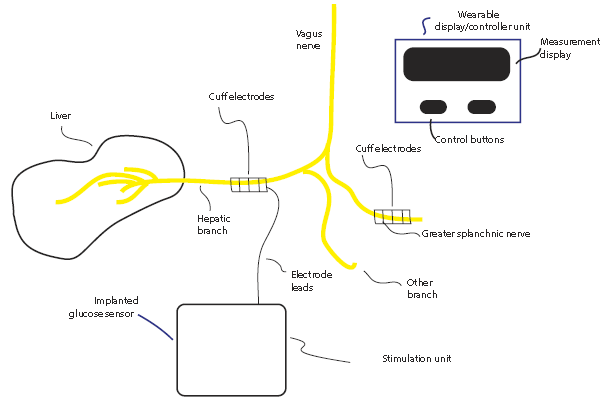Inventors at Georgia Tech have developed a device to either increase or decrease the neural activity in the hepatic vagus and/or greater splanchnic nerves to increase or decrease systemic blood glucose levels as a treatment for metabolic disorders such as Type II diabetes. The device can also be used to monitor blood glucose levels in real time and, as needed, either stimulate or block the vagus nerve in order to achieve a desired blood glucose level. The portable device, powered by batteries, can measure and log blood glucose levels, control an externalinsulin pump, and increase or decrease nerve activity to obtain the desired blood glucose level. The device can also operate such that the user assumes control of the device, the clinician or user sets a set point, or in a configuration where the device optimizes a user or clinician based set point and electrically stimulates to maintain the set point.
- Needle-free blood glucose control.
- Potential to either eliminate or decrease use of blood glucose control medications.
- First demonstrated use of electrical stimulation to inhibit nerve activity to cause a decrease in measured blood glucose levels
This medical device would be useful in the treatment of Type II diabetes and other metabolic blood glucose disorders. As the vagus nerve not only interacts with various organs, the vagus nerve comprises between 80% and 90% of the nerves that convey sensory information about the state of the body's organs to the central nervous system. Therefore, the development of this technology is also potentially applicable to a number of other human diseases.
The vagus nerve, the longest autonomous nerve in the human body, is responsible for a multitude of tasks such as heart rate, gastrointestinal peristalsis, sweating, and muscle movements in the mouth, including speech. Since the first implantation of a cardiac pacemaker over 50 years ago, there has been an interest in devices that stimulate nerve activity to relieve clinical conditions. The first human vagal nerve stimulator was implanted in 1988 for the treatment of seizures. It has been demonstrated that electrical stimulation of the vagal nerve increased pancreatic release of insulin and glucagon in pigs and dogs. Moreover, research has shown that activation of the vagus nerve reduces hepatic glucose release and increases pancreatic insulin secretion in hyperglycemic conditions.

